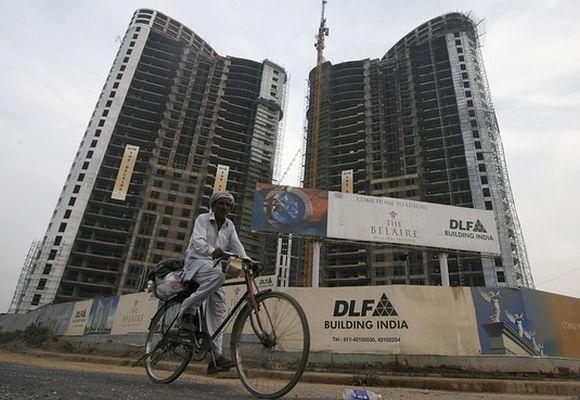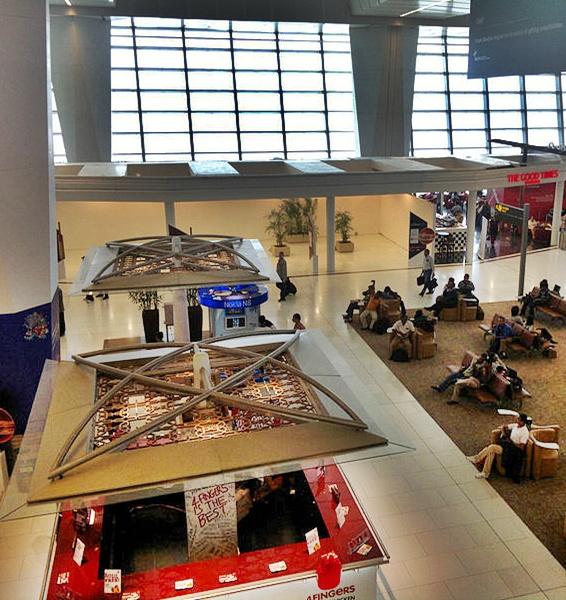An airport in Noida could lead to higher user fees and diversion of traffic from Delhi, which has huge unused capacity.

Photograph: B Mathur/Reuters
A junior minister normally does not interest the media much, but Mahesh Sharma stirred up a hornet’s nest on assuming office as minister of state for civil aviation last month.
Among his first statements as minister was one where he said he would try to revive the plan for a second international airport in Uttar Pradesh at Jewar in Greater Noida.
The project was conceived more than a decade ago in 2001 but had been caught in the political crossfire of governments from three different parties.
Sharma, a member of Parliament from Gautambuddh Nagar, said discussions will be held with Prime Minister Narendra Modi to finalise the proposal. He cited infrastructural constraints in the national capital region for the renewed interest in the initiative.
“Strategically, Noida and Greater Noida have great industrial potential and, therefore, infrastructure would be needed. It would also generate jobs. Therefore, there is a need to develop an airport in this belt,” he said.
“The new airport project in Jewar is an important project. It has to be discussed in the wider interest of the nation. The airport is not a project of Mayawati or Mulayam Singh, but of India.”
The Jewar airport proposal was first mooted in 2001 by Rajnath Singh, who was then the chief minister. It was endorsed by his successor, Mayawati.
However, the Akhilesh Yadav government withdrew the proposal citing a clause that bars the development of a second airport close to an existing one.
The development of the airport in Greater Noida would benefit real estate developers who have been hit hard by the economic slowdown. There has been little activity and sales have been slow over the past two years.
With inventory running mile-high, developers have been focusing on clearing the backlog instead of launching new projects. Inventory levels across India have been rising over the past two years.

While an ideal market maintains an inventory of eight months, the Mumbai Metropolitan Region had an inventory of 53 months at the end of June 2014, while the National Capital Region had an inventory of 45 months, data by research firm Liases Foras showed.
Hyderabad had an inventory of 47 months, Pune 23 months and Chennai 26 months. Bangalore had the smallest inventory among the major cities of 19 months.
Given this situation, infrastructure creation in the form of a new airport would help correct realty prices in the belt.
However, a second airport at Jewar goes against the existing policy. The distance between the proposed site and New Delhi’s Indira Gandhi International Airport, or IGIA, is less than 150 km.
According to the current norms, “No greenfield airport will normally be allowed within an aerial distance of 150 kilometers of an existing airport. Where it is allowed as a second airport in the same city or close vicinity, the parameters for distribution of traffic between the two airports will be clearly spelt out.”
The government can, however, approve a greenfield airport at places where an existing airport is unable to meet the projected requirements of traffic. It can be allowed both as a replacement for an existing airport or for simultaneous operation.
Given that in 2013-14, traffic at Delhi airport increased to 36.9 million from 16.2 million in 2005-06, industry observers say there is ample room for growth as well as additional capacity expansion at IGIA itself.
The airport currently has the capacity to handle 62 million passengers per annum. A fourth terminal and runway is planned, and this can take traffic-handling capacity to 100 million per annum.
Amber Dubey, partner and India head (aerospace and defence) at global consultancy KPMG, says, “Airports are a lumpy investment. Once built, they have to be sweated completely before going for a second airport as in Mumbai, Goa and Chennai. The Delhi airport, a triple-runway airport with a large land mass and a throughput of just 37 million passengers annually, has a long way to go before it gets exhausted. There are plans for a fourth runway and the fourth terminal. It may be better to invest in metro and signal-free road connectivity to the airport than invest in new airports in NCR. The connectivity so created would benefit not just the airport users but everyone along the rapid transportation corridors.”

Higher user charges
Dubey fears the development of a second airport in the national capital region would lead to higher user charges.
“Creating a second airport in Delhi before IGIA gets saturated may render both airports unviable. User charges at both airports will rise since the operating cost and capital expenditure at both airports would be spread over the same flyer base. Airlines may not like to split operations at two nearby airports given the high fixed cost, unless of course they can’t add any further slots or cargo handling space at the older location,” he says.
Highly-placed officials in the ministry of civil aviation too are apprehensive about the project. “The state government has already scrapped the proposal, so how can we take it forward?” asks a senior official. Besides, there are contractual obligations that the government has towards Delhi International Airport Limited that operates IGIA.
But Sharma argues otherwise. He says, “The population in Delhi-NCR is projected to increase to 2.45 million by 2030 from the current 1.6 million. The existing infrastructure would not be able to support such growth. There is a need to develop a second international airport, and Jewar is the closest place to Delhi that has land available for use.” Over 2,378 acres of land, spread across 35 villages, was acquired in 2003 for the airport in Hewar, which falls in Sharma’s constituency, and there is more land available if needed.
Kapil Kaul, chief executive officer (South Asia), Centre for Asia Pacific Aviation (CAPA), is not entirely dismissive of the idea.
“Land earmarked earlier for the Greater Noida airport should have been acquired for the second airport in the national capital region,” he says. “Land acquisition now will be costlier and could also face challenges. It will take 5-7 years, if fast tracked, for the second airport to become operational, the earliest possibly being 2021-22, by when IGIA will be closer to its structural capacity.”

Photograph: Courtesy, Ramesh N G/Wikimedia Commons
He adds that whether a second airport comes up or not by 2022, IGIA will remain competitive and a critical airport with a very strong network density. “India’s airport development plan lacks a long term focus. We need a structured master plan for airports that can last more than a generation (three to four decades) and is integrated to the overall national transport infrastructure plan,” says Kaul.
The Jewar project, if sanctioned, could change the policy on greenfield airports at a time when the government is aiming at increasing air connectivity by developing budget airports in smaller cities.
The government has said it will encourage the participation of the private sector in such projects to tap into resources as well as expertise. An institutional framework would be established for the same, while regulators would be given greater autonomy as well as accountability.
Overall, infrastructure creation in the form of modernisation of existing airports and development of low-cost airports to promote air connectivity, particularly to remote and regional areas, is a major area of focus for the Modi-led government.
After all, the issue was part of the Bharatiya Janata Party’s election manifesto, in which it spoke of the “potential for (developing) inland air transportation to various remote and local locations in the country. Such air strips will be developed so that low cost air travelling becomes possible within the country”.











